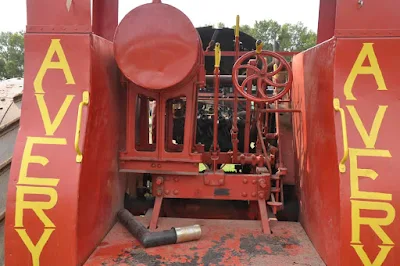Wednesday, September 30, 2015
Tuesday, September 29, 2015
Monday, September 28, 2015
Sunday, September 27, 2015
Saturday, September 26, 2015
Friday, September 25, 2015
Thursday, September 24, 2015
Wednesday, September 23, 2015
Tuesday, September 22, 2015
Monday, September 21, 2015
Sunday, September 20, 2015
Saturday, September 19, 2015
Friday, September 18, 2015
Thursday, September 17, 2015
Wednesday, September 16, 2015
Tuesday, September 15, 2015
Monday, September 14, 2015
Sunday, September 13, 2015
Saturday, September 12, 2015
Ford-Ferguson Variations
These are variations on Ford-Ferguson tractors. Both of these tractors may be 9N models built between 1939 and 1942. Companies other than Ford made these accessories to be bolted onto standard tractors. A total of more than 830,000 of the N model Ford tractors were manufactured between 1939 and 1952. Many of these tractors, now antiques, are still in use around farms. Over the years of production the motor increased in power. The original 9N models came with 20 horsepower motors which later increased to 25 hp in the 8N of 1947-1952. All three early N model Ford-Ferguson and Ford tractors were the same machines with a few changes. These reliable, inexpensive, hard working tractors convinced farmers to move away from farming with horses to mechanizing their farms.
From 1915 to 1939 when the 9N Ford-Ferguson tractor was introduced the number of horses and mules used on American farms had already fallen by half. In 1938 there were 11,163,000 horses and 4,477,000 mules providing power on farms according the U.S. Farm Census. By 1952 when Ford ended production of the popular little 8N tractor the number of farm horses had fallen to 4,330,000 and mules to 1,913,000. When the 9N was introduced by Ford it cost $585 (this is equal to $9,812 in 2015 dollars), not much more than the cost of a single horse.
Friday, September 11, 2015
Fordson Tractor
This tractor is a Fordson Model F built from 1917-1928. The company name was Henry Ford and Son, Inc. got shortened to Fordson for the tractor name. This was the tractor that out competed horses on farms and put many of the manufacturers of steam traction engines and giant oil pulls out of business. Henry Ford designed this tractor to use some of the same parts as in his cars and trucks. The Nebraska Tests measured 14 drawbar horsepower and 26 belt horsepower making it perfect for agriculture. It pulled 1813 pounds at the drawbar at 3.21 miles per hour. In 1921 Ford sold 35,000 of these machines in the U.S. and around the world. Sales increased to 67,000 in 1922, and 100,000 in 1923.
It originally sold for $785 (equal to $10,829 in 2015 dollars), but when International Harvester and John Deere brought out competitive tractors, Ford dropped the price to $620, and then later to $395 (or $5,422 in 2015 dollars). In 1928 Ford dropped the tractor business, but continued to supply motors to Harry Ferguson in Great Britain who made many advances on the Model F eventually resulting in the 1939 Model 9N built in Ireland and imported into the U.S. as a Ford-Ferguson. They were later built in the U.S. by Ford to become the most popular tractor of all time. By 2001 half of all 9N Ford tractors were still in operation while the other half are stored waiting for restoration.
Thursday, September 10, 2015
Wednesday, September 9, 2015
Tuesday, September 8, 2015
Monday, September 7, 2015
Sunday, September 6, 2015
Saturday, September 5, 2015
Aultman Taylor's Old Trusty
Aultman Taylor was a manufacturer of steam traction engines used for agriculture and construction. By 1910 they became aware that steam power was on the way out so they manufactured their first gas tractor, the Aultman Taylor 30-60 gas tractor in 1911. The same model continued until 1924. These tractors start on gasoline then switch to cheaper kerosene after the motors are fully warm. Some of the numbers associated with this tractor are impressive. It weighs 24,500 pounds. The massive radiator takes 120 gallons of water, and some of that water is injected with fuel into the cylinders. The water helps cool the motor and provides a seal for piston rings and valves. Depending on operating conditions up to nine gallons of water and kerosene can be burned per hour under heavy loads. The company called this machine "Old Trusty," and the Nebraska Tests commented that this tractor produced more power and ran more economically than any of its competitors in this era.
Friday, September 4, 2015
Thursday, September 3, 2015
Wednesday, September 2, 2015
Tuesday, September 1, 2015
Avery 25-50
This 1920 Avery 25-50 built in Peoria, Illinois is called that because it produced 25 horsepower at the draw bar and 50 horsepower at the belt pulley. These "oil pulls," so called because they burned kerosene, were often used to power belts that ran thrashing machines and saw mills, but they also pulled implements in farm fields. While the horsepower numbers are not impressive, these machines produced large amounts of torque to pull six plow bottoms through tough soils. The motor is four cylinder, horizontal opposed, valve in head, with a bore of 6.5 inches and stroke of 8 inches. It was designed to run at 700 RPM. In low gear it went two miles per hour and in high gear it goes three miles per hour. Depending on how hard the tractor is working, it burns between five and seven gallons of kerosene per hour so with its fifty gallon fuel tank it could work eight to ten hours. This tractor weighs 12,500 pounds. The Avery Machine Tool Company went out of business in 1924 because farmers were looking for smaller, lighter, cheaper tractors which could be operated by a single individual.
Subscribe to:
Comments (Atom)






































